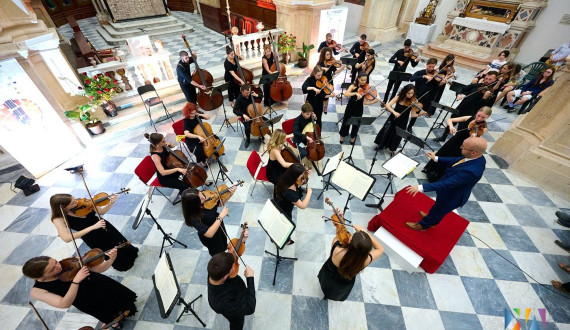The Music of Hope or Hope in Music
After the high artistic achievements in the first part of the Festival, with exceptional young musicians gathered in the Camerata Balcanica Chamber Orchestra, the steady voices of the Ivan Goran Kovačić Academic Choir and a flawless presentation of authentic baroque music of the Accademia Bizantina Ensemble, a concert called The Music of Hope was held at KotorArt. In the Church of Our Lady in Prčanj, on Thursday July 29, the Western Balkans Youth Orchestra, gathered around the idea of mutual understanding, led by conductor Desar Sulejmani, performed the works of Grieg, Dvořák, Druga, Tansman and Shostakovich.

The Western Balkans Youth Orchestra was founded as a natural outgrowth of the European Summer Academy of Music in Pristina, on the eve of the pandemic, which is why they are presenting the results of their work only this year. The orchestra gathers young musicians from six Western Balkan countries – Albania, Bosnia and Herzegovina, Kosovo, Montenegro, North Macedonia and Serbia, although the performance at KotorArt itself showed that the “structural” concept differred by also engaging the musicians from countries outside the Western Balkan region.
When it comes to the repertoire, the musicians presented major works for string orchestra – Suite in olden style (From Holberg’s Time) by Edvard Grieg and Chamber Symphony Op. 110a by Dmitri Shostakovich, followed by a work less known to the public – Variations sur un theme de Frescobaldi by Alexandre Tansman, as well as one work by the Albanian composer Gerti Druga – Feathers of Sorrow. Although the interpretation seemed solid and confident at the very beginning (Grieg), the performance was also characterized by occasional intonation inaccuracy (Shostakovich), as well as an insufficiently profiled balance between the parts (Tansman). Obviously, the previous performances of this ensemble brought a dose of self-confidence among the members of the Orchestra. However, this very experience should have provided space for the improvement of the interpretations themselves. After Grieg’s Suite, another piece was performed at the concert that was not planned in the program – a movement from Antonín Dvořák’s American Quartet. Although this choice was explained by Sulejmani as the need to present the work done at master classes at the European Summer Academy of Music in Pristina, and that the quartet is formed of four musicians from Montenegro, Germany, Kosovo and Serbia, the fragmentary presentation of the composition and the abstracted Orchestra broke the concept of the musical event as a whole.
The activities and scope of the Western Balkans Youth Orchestra must be viewed not only from a musical perspective, but also from the aspect of social engagement. Through mutual cooperation, the goal of the Orchestra is for the musicians to overcome issues of ethnicity and culture differences, such as those arising from the disintegration of the former Yugoslavia. In this way, the members of the Orchestra become genuine ambassadors in the region, one marked by historically recent disagreement and strife. In view of this, an additional question arises, on the trail of the narrative theory of the colonialization of the Balkan people, which Vesna Goldsworthy bases on the British literature of the 19th century – it is the question of changing the (distorted) Western European perception of the Balkans as the “Wild East of Europe”. In other words, it is interesting to review the capacities of such and similar projects in the field of culture and think about how (and whether) they contribute to overcoming prejudices about the Balkans, and, finally, influence the reshaping of the socio-political construct in the region.
